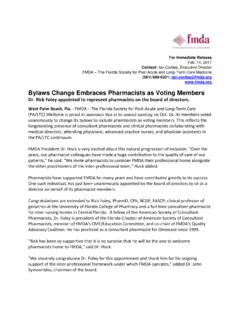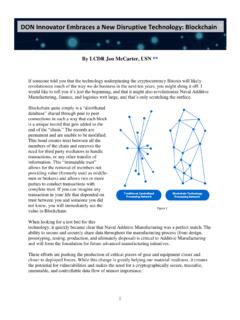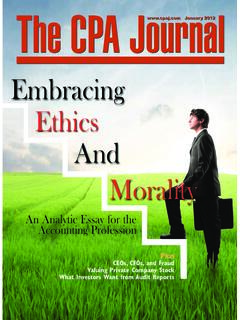Transcription of Next Generation Compliance: EPA embraces technology and ...
1 ABA Section of Environment, Energy, and ResourcesTrends July/Aug 2016 Published in Trends July/Aug 2016, Volume 47, Number 6, 2016 by the American Bar Association. Reproduced with permission. All rights reserved. This information or any portion thereof may not be copied or disseminated in any form or by any means or stored in an electronic database or retrieval system without the express written consent of the American Bar Generation Compliance: EPA embraces technology and transparency to promote compliance with environmental lawsChrisna BaptistaChrisna Baptista is an attorney-advisor in EPA s Office of Enforcement and Compliance Assurance. The views expressed in the article are those of the author and do not necessarily represent official Environmental Protection Agency Gen can magnify environmental protection effortsProtecting the environment and ensuring that communities are safe from pollution is a regulatory task that is more complex today than ever.
2 To achieve its mission of protecting human health and the environment, the Environmental Protection Agency (EPA) uses a variety of approaches, including establishing and enforcing sound regulatory programs. We know that a strong regulatory presence alone cannot ensure compliance with environmental laws. Overseeing regulated entities is challenging, especially when the source of pollution is not readily apparent, or when a large number of small sources collectively impact the environment. EPA s Next Generation Compliance (Next Gen) strategy is transforming how EPA, states, and regulated entities approach environmental five components of Next Gen provide principles and tools that can help regulated entities identify and fix pollution problems before they become violations. These tools can increase compliance by helping facilities understand their environmental impacts while informing communities closer to real-time about the performance of regulated sources and government oversight.
3 Next Gen s five components are:1. Designing rules and permits that are clear, easy to implement, and contain self-reinforcing drivers, such as independent third-party verification;2. Utilizing advanced monitoring technologies by regulators, companies, and citizens to find pollution that was previously invisible and to transmit warnings to those responsible for fixing problems and to ensure that violations do not occur;3. Implementing electronic reporting that offers more ease and efficiency and at a lesser cost than paper forms;4. Requiring transparency to provide facilities and the public access to better information on source emissions, discharges, and key compliance activities and to promote accountability; and5. Encouraging innovative enforcement that improves the effectiveness of settlements by allowing EPA and the public to ensure that defendant(s) fully comply with settlement terms and schedules.
4 Considering how to implement Next Gen in settlements is now ABA Section of Environment, Energy, and ResourcesTrends July/Aug 2016 Published in Trends July/Aug 2016, Volume 47, Number 6, 2016 by the American Bar Association. Reproduced with permission. All rights reserved. This information or any portion thereof may not be copied or disseminated in any form or by any means or stored in an electronic database or retrieval system without the express written consent of the American Bar s standard practice and has been demonstrated in numerous s use of Next Gen to promote complianceNext Gen looks for ways to design environmental programs that will ensure successful regulatory compliance. Next Gen has resulted from EPA recognizing opportunities to dramatically change the future by embracing new technologies and best practices in EPA s rule development, implementation, compliance, and enforcement activities.
5 By partnering inside and outside of EPA, Next Gen seeks and encourages better performance from regulators and the regulated. Some key examples of EPA s use of Next Gen are: EPA s proposed amendments to the Accidental Release Prevention Requirements of the Clean Air Act Section 112(r) s Risk Management Programs (RMP) in March 2016. The proposed RMP rule aims to modernize EPA s chemical safety and security regulations to prevent chemical accidents by, among other things, requiring that facilities with a history of accidents or other noncompliance conduct independent third-party audits. Because of the importance of maintaining independence in assuring objective audits, the rule s criteria limit past, present, and future business relationships between owners/operators and auditors.
6 EPA s recent petroleum refinery rule requires emissions to be monitored at the fence line of facilities, helping to detect pollution affecting communities, while leading to corrective actions before problems become violations. Incorporating such monitoring technologies into rules provides real-time information sharing among facilities, regulators, and communities surrounding facilities. EPA s National Pollutant Discharge Elimination System (NPDES) e-reporting rule replaces most paper-based Clean Water Act NPDES permitting and compliance monitoring reporting requirements with electronic reporting and will save millions of dollars for states, EPA, and companies. Even without changing underlying substantive limits or standards, simply updating rules to require electronic reporting offers speed, convenience, and cost savings, while smart forms help regulated entities report accurate and complete data with improved transparency .
7 The Greenhouse Gas Reporting Program (GHGRP) requires over 8,000 facilities across 40 industry types to monitor greenhouse gas data, including emissions, and annually report them to EPA through an electronic system, which runs real-time checks for common mistakes. EPA verifies GHGRP reporting data using a combination of electronic checks and manual reviews to identify potential errors and makes the data available to the public through an interactive data publication tool called Facility Level Information on GreenHouse gases Tool (FLIGHT). In 2014, EPA began publicly flagging facilities with unresolved errors or ones that did not provide a valid reason for an absent report by giving them an orange facility symbol in FLIGHT, using transparency to ABA Section of Environment, Energy, and ResourcesTrends July/Aug 2016 Published in Trends July/Aug 2016, Volume 47, Number 6, 2016 by the American Bar Association.
8 Reproduced with permission. All rights reserved. This information or any portion thereof may not be copied or disseminated in any form or by any means or stored in an electronic database or retrieval system without the express written consent of the American Bar improved accountability. A 2013 settlement with Walmart expanded the use of electronic reporting and advanced monitoring to create a system in which Walmart store employees electronically scan damaged store products in real time to allow them to identify items that should be treated as hazardous waste and quickly learn how to properly dispose of the damaged product under the Resource Conservation and Recovery Act. Settlements that incorporate Next Gen can be used to improve compliance throughout an does Next Gen go from here?
9 EPA is implementing Next Gen today by using new technologies and best practices in every aspect of its work, from rulemaking and permitting to enforcement. When states, EPA, citizens, and industry have real-time electronic information regarding environmental conditions, emissions, and compliance, this can lead to time and resource savings, and more accurate monitoring and reporting. Under the Next Gen strategy, compliance will be easier to identify across entire sectors. As EPA continues to learn about ways to strengthen compliance and take advantage of advances in technology , Next Gen can transform our protection work and improve our ability to meet environmental challenges today and into the future.



















